Special: Now you see it, now you don't.
Of Terror, a Plague and JC
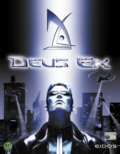
Deus Ex isn't exactly a stealth game, but it isn't not a stealth game, either. When Ion Storm released the game in the summer of 2000, they created an open-ended experience that allowed the player to define his or her own style. Playing as JC Denton in a crumbling society rife with conspiracy and competing factions, gamers were able to build a character with skills ranging from pistol and rifle proficiencies to medicine, computer hacking and swimming. Coupled with a set of dialog trees that would truly be at home in any RPG, this meant that Deus Ex played differently for everyone who took up its challenges and could certainly be played in significantly different ways on successive play-throughs. The game was followed in December 2003 by Deus Ex: Invisible War, but the sequel was far from the critical and commercial home run that was the original. The fact that the original hit so many Game of the Year lists probably helped set an unreasonably high standard for the sequel.
Of course, the mode we're most concerned with here is the stealth mode. The game certainly allows for first person shooter type gameplay, since it provides plenty of potent weapons like the assault shotgun, the flamethrower, and the devastating GEP gun, which used a laser targeting system to fire powerful explosive weapons great distances. Deus Ex also allowed the player to develop the skills to make using these weapons second nature. But playing Deus Ex in a pure stealth mode required the player to forgo these weapons and skills. The game offered a whole different skillset for the stealth-minded player. For instance, stealth players might develop the УLow-techФ weapons skill, which would improve proficiency with the baton and the electric prod. The prod was the perfect high-tech replacement to Thief's blackjack: it incapacitated opponents without killing them. Likewise, stealth players would likely choose to upgrade their lock picking and electronics skills in order to bypass various types of physical and electronic security without spending scarce disposable lock picks or multitools from their inventory.
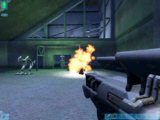
The depth of character customization was a huge plus in this game, even if some players might have complained that its graphics looked dated even in the year 2000. For instance, a player who wanted to lean more toward the sniper end of the stealth spectrum could develop their pistol skill and then heavily modify their mini crossbow for accuracy in order to use tranquilizer darts for silent, nonlethal takedowns from a distance. On top of at least eleven learnable skills and about eight weapons modifications, the original Deus Ex offered more than twenty biomods. JC Denton was an agent for the multi-government agency UNATCO, and as such, was subject to experimental nanotech augmentation that gave him superhuman skills.
Some skills, such as УRun silent,Ф УCloakФ and УRadar transparencyФ had obvious implications for stealth players. Cloak, for instance, actually helped Denton blend into the surroundings and make him invisible to opponents, while Radar transparency would do the same for a variety of electronic surveillance equipment including video cameras. Hardcore players were more than a bit annoyed to find out that the customization system had been greatly simplified for Invisible War. The skill system was eradicated and the biomods were now greatly simplified, offering only about 15 possibilities that included some of what were skills in the original game. And biomods could be swapped out as desired, making these choices much less important to the overall game.
Beyond the customization system, players of both the original and the sequel generally praised the depth of the Deus Ex world and the complexity of the storylines. Both games offered plots full of conspiracies, coverups, and competing government agencies that gradually unfolded as the player discovers hidden intrigues and hidden agendas. Players tended to run through the games more than once, since different choices at key moments would impact how different scenes played out. The plot was generally linear, so differences were local, but each game did lead to three to four alternate endings based on decisions that Denton made near the end. Invisible War increased the players' role in the story and allowed them to choose an alliance with one of a few factions presented in the game. Some missions were associated with a particular faction, and would therefore not be received by players aligned with the wrong faction.
One of the nicest little touches in the original Deus Ex was that the minor NPCs would react to the individual player's style of play. For instance, at one point in the game, the player would stumble into a firefight between UNATCO and terrorist forces. If the player ignored the fight on the way to completing the primary objective, an NPC in a later level might comment on the fight and mention how Уsome peopleФ were grumbling about Denton's lack of participation. In most games, these minor characters are no more than window dressing, semi-mobile background props.

In 2005, Ion Storm closed its doors for good after a series of releases that were often over budget and failed to live up to expected sales, including Invisible War, Thief: Deadly Shadows (Ion Storm acquired the rights to Thief after the closure of Looking Glass), Anachronox, and Daikatana. When Invisible Wars was released, developers Crystal Dynamics were working on a third game in the series intended as a multiplayer tactical experience called Deus Ex: Clan Wars. Although publisher Eidos claimed that the game began to Уtake its own directionФ and was therefore re-branded as Project: Snowblind, one wonders how much the commercial failure of Invisible Wars had in this repackaging, since the final Snowblind release features biomods and a world in turmoil similar to that of Deus Ex. Stealth aficionados will be disappointed with the game, however, since it doesn't allow for much in the way of sneaking.
Like with Thief, Deus Ex fans looking for more still have a lively mapping and modding community to turn to. The Zodiac mod re-tells part of the original Deus Ex storyline from the point of view of Paul Denton, JC's clone Уbrother.Ф Likewise, the Cassandra Project mod offers new missions with a new main character. And the High Definition Texture Pack project is working on cranking out just that: better-looking textures for the original Deus Ex. For anyone who loves the game but isn't satisfied with the original, circa 2000 Unreal Engine, the DXR team is working on a mod for UT2004 that will bring the Deus Ex gameplay to the more capable Unreal Engine 2.
WWII? Of course!
There's no way that stealth gaming could escape the influence of the single most pervasive setting for gaming on just about any platform. The first title that will likely come to mind when thinking of WWII stealth is the Commandos series, which placed the player in control of a sneaky but powerful team of commandos in a set of generic WWII situations often (quite loosely) based on classic movies like The Bridge on the River Kwai, The Guns of Navarone and The Great Escape. The Commandos series began in 1998 with Commandos: Behind Enemy Lines and continued in 1999 with the standalone expansion Commandos: Beyond the Call of Duty, but it was with the 2001 release of Commandos 2: Men of Courage that the series hit its peak. Sequels came and went, including Commandos 3: Destination Berlin, which wasn't much more than a simplified version of Beyond the Call of Duty, and Commandos Strike Force, which took the game into the world of the first person shooter.
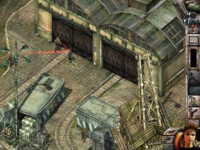
That's rightЧthe first four installments of Commandos weren't from the first- or third-person perspectives. Nor were they the old isometric perspective from Wolfenstein or the early Metal Gear. The Commandos interface was more like that of an RTS, with a context-sensitive mouse pointer, a menu of clickable icons, and a set of status indicators, all of which allowed the player to control a team of usually three to five unique characters at once. The player could give individuals a variety of orders, like moving to a location, crawling and attacking. There were also plenty of commands that came in handy for keeping things stealthy: knocking on walls and throwing items to distract the enemy, knocking out an enemy guard and tying him up, and moving items like barrels and bodies. Other commands were related to the specific skills of a team member. For instance, Natasha the secret agent was able to distract and seduce enemy soldiers, making it easier for the rest of the team to do its thing. Duke the sniper could climb telephone poles for a better view of his targets. And Lupin the thief was the only one who could climb walls and make his way through certain tiny gaps. By all accounts, Men of Courage was a tough game with the emphasis placed on sneaking around the enemy, distracting them, and disabling them silently without alerting nearby reinforcements. To make this a bit more manageable, the game showed all enemies at all times without any Уfog of warФ effect. It also displayed enemy lines of sight on the terrain to help players keep their troops hidden.
WWII also inspired two very conventional stealth-based games: The Great Escape (Gotham Games, 2003) and Prisoner of War (Codemasters, 2002). Neither game was terribly successful at the time, but they're both a bit of stealth game history and either one could satisfy a dedicated stealth gamer looking for a fix. Each game casts the player as an Allied pilot in a prisoner of war camp during the war: Stalag Luft III in the case of The Great Escape, and both Luft and Colditz for Prisoner of War. The missions are similar in the two games: move around restricted areas of the camps in order to collect the material needed to implement your escape plans while dodging plenty of search lights and eagle-eyed guards. The Great Escape had more variety, since the player occasionally got into some shootouts and was able to drive a few vehicles, but the stealth game was more developed and better rounded in Prisoner of War.
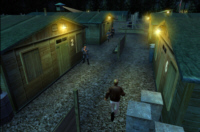
The Great Escape is based on the movie of the same name, and the player gets the chance to fill the shoes four movie characters, including characters played by James Garner and James Coburn, not to mention the Steve McQueen character, Captain Hilts. Although the game had players doing plenty of sneaking and peeking, it didn't do much to expand the genre. It did have several different postures, including a prone low crawl posture that allowed the player to roll to the left and right under obstacles or cover. It also had a peek through the keyhole feature that could be used to check for sentinels before opening a door. But a couple of annoying elements made this game difficult in all the wrong ways. For instance, players were limited to a max of four saves per level (less if playing on medium or hard), meaning lots of repetition in challenging areas. While most of the game relied on the stealth play, a few levels put a weapon in the player's hands. The problem was that the aiming mechanism in the PC version was unrefined, to say the least, making it tough to get the bad guys before they got you. A few bottlenecks where the player had to stand up against just two or three German soldiers could cause many, many replays.
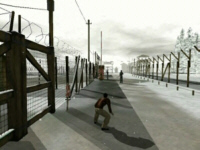
Prisoner of War was a bit more innovative when it came to the stealth play, and it never put a weapon in the player's hands. In fact, despite the WWII setting, there was no no killing in this game at all. The player couldn't perform any stealth kills, and when he was captured, he was either sent to solitary confinement, or if wounded, to the infirmary. Either way, he lived to escape another day. And speaking of days, one of the coolest features of the game was its dynamic day/night cycle: a clock in the upper left corner of the screen kept constant time, and players had to work their stealth missions in around the camp schedule. Missing roll call, a meal, or getting spotted after lights out meant a night in the cooler. The semi-realtime clock gave the game a life that artificially imposed countdowns in other games don't have: sneak around and lift some travel documents before dinner and then come back overnight for a uniform. Prisoner of War added to this sense of life inside the camp by having the player interact with NPCs in order to get mission objectives via RPG-style dialog trees. And sometimes, those characters would only give up information or needed items in exchange for camp scrip or contraband items which the player had to find and steal from various locations around the camp. The objectives in Prisoner of War were often complex and required the player to move throughout the various camps in order to complete them. The downside to the game lay in some improbable plot elements: camp directors leading rocket research, stereotype characters, and stiff dialog.
The Story of a Man Named Sam


It's hard to believe that Ubisoft first released Splinter Cell for the Xbox less than five years ago, in November of 2002. The franchise has become a fixture of stealth gaming, an icon of all that's best in the genreЧand also of its shortcomings. The popularity of the original guaranteed sequels, with Splinter Cell: Pandora Tomorrow released in early 2004 and Splinter Cell: Chaos Theory following a year later. A cross-platform game, Splinter Cell has seen everything from PS2 to PC, GameCube to Game Boy Advance, N-Gage to Nintendo Wii, not to mention a version for mobile phones. Along with Metal Gear, it's one of the few stealth franchises still in production, with the fourth installmentЧSplinter Cell: Double AgentЧreleased back in November of 2006 and a fifth game in the works, exclusive to the Xbox 360 and PC, tentatively named Splinter Cell: Conviction.


Aside from being the game that seemingly can't die, Splinter Cell has always been an example of the stealth game par excellence. Splinter Cell games generally require the player to rely on staying out of sight rather than using force, even though main character Sam Fisher is armed with a nifty silenced pistol and scoped rifle. Limited ammunition and much slower movement when carrying a weapon at the ready both helped make the use of force a bad choice, except as a last resort. The first games in the series were especially unforgiving, since any alarm that sounded during a mission resulted in failure. This frequently resulted in tough going, requiring heavy use of the PC version's save anywhere feature when sentries found a poorly-hidden body or glimpsed Sam as he stalked the shadows. And like the Thief series, Splinter Cell features a visibility meter that gauges the amount of light falling on the Sam at any given time.
Splinter Cell was also true to stealth form in that its missions depended on scripted encounters and triggers that meant the levels would be identical on successive play-throughs. This meant that the single-player campaign didn't offer much replay value and also that when players hit a rough spot, playing the same sequence several times in a row would be a very repetitive experience. Plenty of stealth games fall into this trap, and the later entries in the Splinter Cell franchise tried to alleviate the pain a bit by allowing for multiple paths through an area, not unlike Deus Ex. If one course of action wasn't working, players could look around and perhaps find a bit of ductwork to enter or a pipe to shimmy up in order to get a new angle on the problem.

Splinter Cell brought stealth gaming into the 21st century, so to speak, with both state of the art graphics and high tech in-game equipment. While critics and players noted that some earlier games like Thief and Deus Ex didn't live up to their graphical expectations even at the time of release, the Sam Fisher vehicles have never faced such complaints. The first two installments were built on the Unreal II engine and put its dynamic lighting and shadow capabilities to the test: Splinter Cell featured detailed textures and character models, cool night vision and heat sensor effects, and all sorts of dynamic light and shadow effects. Some of the game's most memorable visuals involved things like neon lights and strong sunlight streaming into a dark, hazy rooms. One of its most impressive features were the curtains that not only looked good, but were functional. Sam could hide behind them to avoid detection, and then when he moved on, the curtains would move with him, draping realistically over his shoulder, and then fluttering a bit after he was gone.

Sam was also armed with all the best high-tech gadgets that the good folks at Ubisoft could think up. He carried an array of cameras that allowed him to peek under doors and to surveil areas from a distance. Heat sensing goggles gave him a limited ability to see through walls. And Sam carried several devices that could be considered the equivalent of Thief's water arrows: his camera jammer could temporarily disable security cameras and in Double Agent, a special attachment to his pistol could be used to interfere with not only cameras, but also lights and computers. His weapons were likewise geared toward the stealth mission. Beyond the expected silenced pistol, Sam carried several nonlethal weapons that allowed him to incapacitate an opponent without alerting nearby sentries. For instance, his rifle can fire a camera that would stick to a distant wall and then whistle to attract a guard to investigate. When the guard was close enough, Sam could activate a gas spray that would knock the guard unconscious. The rifle also fired a ring-shaped air foil round that could knock an enemy out if it hit him in the head.

Probably the biggest innovation that Splinter Cell brought to the stealth game was the addition of a multiplayer component with Pandora Tomorrow, something players clamored for way back around the time of the first Thief. Players who weren't interested in the canned experience of heavily scripted single-player missions or who had simply beaten the single-player campaign could now go on-line to complete against live opponents. The multiplayer allowed as many as four players to take up either the role of agent or mercenary and compete in three different gametypes: Neutralization, Extraction, and Sabotage. Each game mode had different victory conditions, but the primary mechanic remained the same: heavily armed mercenaries without stealth skills stand against a team of spies with all the abilities and gadgets of Sam Fisher and then some. In Double Agent, the max player count was upped to six, and spies have only their surveillance equipment and carry no offensive weapons at all. Without a doubt, the addition of multiplayer contributed to Splinter Cell's popularity and helped breathe new life into the stealth game.
Sneaking into the future
Fans of the stealth genre have a lot to look forward to. Even though it looks like we won't be seeing a new Thief or Deus Ex any time soon (if ever), the Splinter Cell franchise is still going strong and there are several new properties to keep an eye out for. DTP Entertainment is working on Sabotage (1943) for the PC, an action-based WWII-themed game that will have players take on the role of Violette Summer, an agent behind enemy lines infiltrating enemy bases and generally wreaking havok. Likewise, Data Fly for the PS3 and 360 from Origo Gaming Entertainment will put the player in the sneaky shoes of a female lead, only with a twist: she's an A.I. construct capable of using nanotechnology to modify her own body and configure weapons at will. This sci-fi themed game doesn't look like it will force players into just one style of play. Instead, players will have Deus Ex-style freedom to shoot or sneak their way across its massive environments.
And Edge of Reality's Cipher Complex is slated to pick up the black ops where Sam Fisher leaves off, combining stealth gameplay with hand to hand combat in what they're calling Уaggressive infiltration.Ф It looks like it will combine the strategy of a stealth game with the excitement of a beat-'em-up. As super soldier John УCipherФ Sullivan, players will skulk in the shadows and then use a combination of fancy fighting moves, a BFK that would make Rambo feel inadequate, and maybe a dash of bullet time to dispatch their enemies. As usual, the developers are promising an A.I. upgrade: common sense. That is, the guards should be smart enough to know when something is up and even remember when something has happened.

Finally, there's Ubisoft's much-anticipated Assassin's Creed going out to everyone who needs a Thiefish fix of medieval stealth. This one will add a highly interactive environment which will allow for acrobatics of the ledge-jumping and roof-climbing varieties. It should also bring a fully-developed fighting system that sounds like vintage Steven Seagal: dodges and redirections and such that will use the opponent's energy against him. It seems that there will be quite a bit of emphasis on combat in this game, since it will also include a variety of swords and knives and bows.
Final Thoughts
When Thief was first released, people had trouble knowing exactly what to call it. It was first person, and the player carried a weapon, but the focus definitely wasn't on the killing and the action. Gaming was clearly evolving into something new, with a new kind of pacing in which players were content to wait in place for a few minutes to observe and examine a situation rather than jumping in, guns blazing. Now, of course, the stealth genre is known as a mainstay on just about every platform and, as a look at upcoming games shows, designers are still looking for ways to push its boundaries and create the next УidealФ stealth experience. Whatever the future holds, stealth games have come a long way over the years. This article barely scratched the surface of this wide-ranging genre and inevitably left out important franchises like the Tenchu and the Sly Cooper series, not to mention titles that aren't primarily stealth games but include stealth as an important play element, like the Hitman series, Chronicles of Riddick, and Syphon Filter, just to name a few. With titles like these making use of the stealth mechanic in one way or another, it's clear that the genre's influence clearly isn't limited to games that call themselves Уstealth.Ф